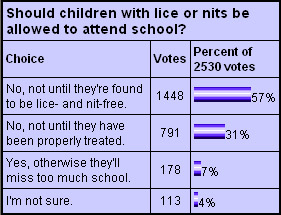|
What is 'Properly
Treated'?
"If you don't get 'em
out, you've still got 'em..."™
In its' June 7th, 2003 issue, the British Medical
Journal (BMJ) touts what they call 'the best treatments for head lice',
all of which comprise serious pesticides otherwise known to be associated
with either toxicity or lice resistance or both. BMJ's discussions
completely ignore the importance of prevention and thorough
manual removal. Because
removal is the bottom line, the FDA requires that every product include a
combing tool (though many of these included combs are of extremely little
use due to poor quality.)
A school nurse asked recently: "How can you verify
that a student has been treated?"
Some suggest there is a difference between 'proper
treatment' and thorough removal of lice and nits. This implies that
you can eliminate lice chemically without thoroughly removing them.
The NPA makes no such distinction. Proper treatment is
thorough removal.
How can one tell when a child is free of the problem
by any method other than the absence of lice and nits?
Despite industry attempts to influence public
opinion, a recent online poll by an NBC affiliate indicates that over 85%
of parents still think that children should be 'properly treated' before
being allowed back into school. Parents do not want lice and nits on
their kids, even if 'experts' tell them it is no big deal.

The NPA says
that proper treatment is
thorough removal of all lice and nits.
Below is a recent example of a dialogue with a
school nurse who posted on a school nurse message board. The school
nurse forwarded it to us and gave us permission to share it with you.
School
nurse asks: "I would like to know how you verify that a student
has been treated?"
Patty Battle-Mutter, RN, MPH: "Check the head for lice or
nits. When you don't find any, that's how you know the child
has been adequately treated."
Another visitor asks: "Patty, I am confused by your post, and
I suspect others might be as well. How does the presence of
lice or nits indicate whether or not the child was treated?"
Patty
replies: "The question is how to know if a child who has been
accurately diagnosed with pediculosis has been treated. First
one must define "treatment." I say this knowing that children
can be "treated", and often in fact will still be infested.
The ultimate determination that they are no longer infested can only
be accomplished with a thorough manual screening of the head to
confirm the complete absence of lice and nits. I require
children with pediculosis to report to my office prior to returning
to the classroom, for a check. When I comb their heads, I can
capture lice that are hidden, or nits that are difficult to see.
In my nursing experience, most of the over- the-counter products on
the market are not effective against head lice. Also, the
prescription products pose a significant health risk to children.
My treatment preference is to rely on manual removal using the
LiceMeister comb. This comb has the FDA's designation as a
medical device, and is the combing tool I prefer. This in
itself constitutes the safest and most effective "treatment" I know
and use on children who need my intervention.
I keep a supply of the combs in my office for parents to purchase.
That way, if I find a child has pediculosis, they can begin treating
right away."
|
The problems often cited with 'No
Nit Policies' are usually a result of poor education and lack of
communication. Parents often try chemical remedies one after another
only to find that nothing is working (often over-exposing their
children to harmful chemicals in the process). If the same parents
were properly instructed in how to effectively deal with the problem at
step one it would make a world of difference.
The NPA's approach is simple and practical: remove
all lice and nits at the earliest possible juncture and regularly screen
to ensure they are gone. Parents should also adopt a healthy habit
of routine screening going forward.
Patty Battle-Mutter, RN, MPH is a nurse with the Shady Hill School in
Cambridge, MA. Patty has joined the NPA in their efforts to spread
the word on the importance of manual removal and protecting kids from
unnecessary chemical exposures. |
|